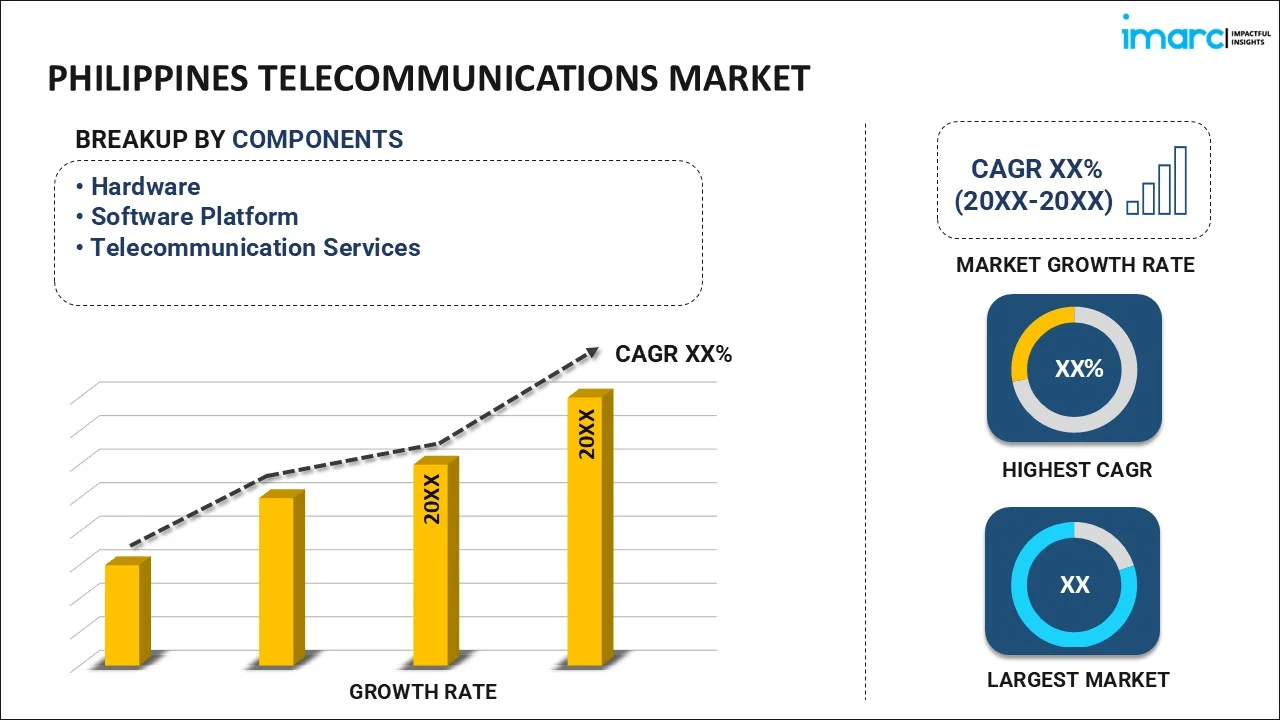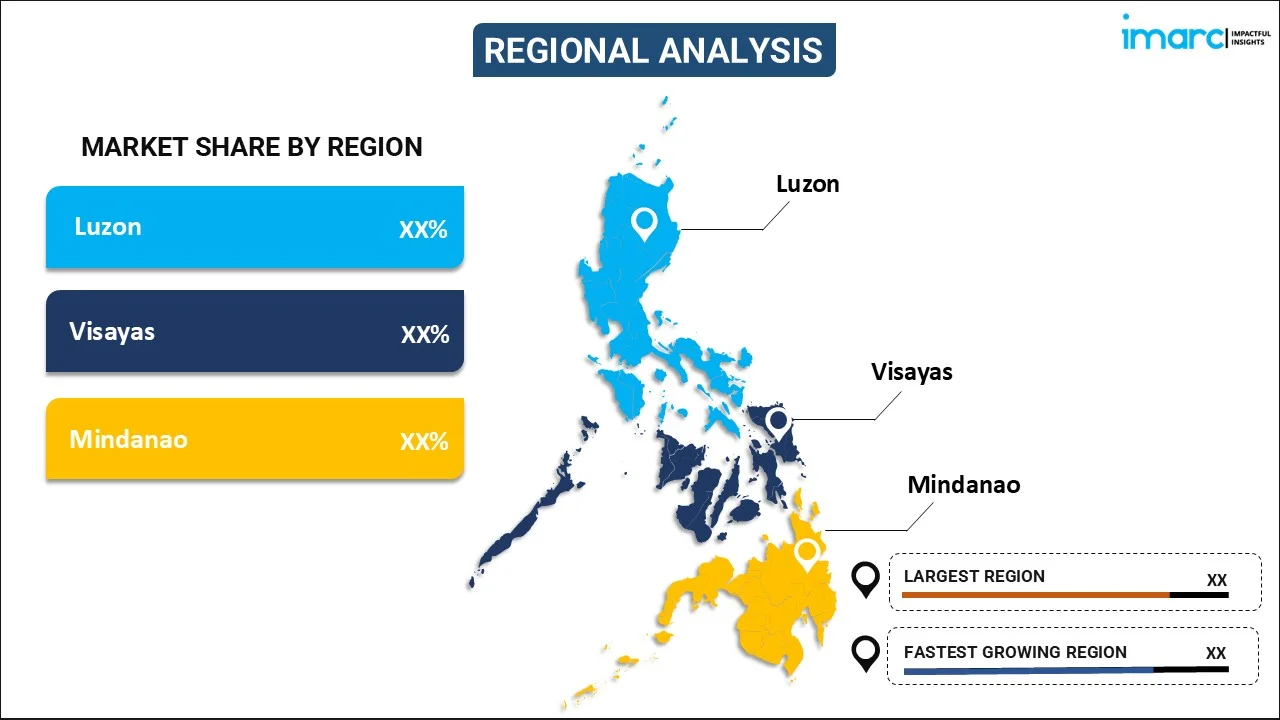
Philippines Telecommunications Market Size, Share, Trends and Forecast by Component, Enterprise Size, Industry, and Region, 2025-2033
Philippines Telecommunications Market Overview:
The Philippines telecommunications market size reached USD 11.48 Billion in 2024. Looking forward, IMARC Group expects the market to reach USD 18.16 Billion by 2033, exhibiting a growth rate (CAGR) of 5.12% during 2025-2033. The expanding mobile connectivity, rising smartphone adoption, surging data demand, enhancing rural coverage, e-commerce growth, ongoing digital transformation, 5G deployment, increased government support and strong investments in network infrastructure and fiber optic expansion are some of the key factors positively impacting the Philippines telecommunications market share.
|
Report Attribute
|
Key Statistics
|
|---|---|
|
Base Year
|
2024 |
|
Forecast Years
|
2025-2033
|
|
Historical Years
|
2019-2024
|
| Market Size in 2024 | USD 11.48 Billion |
| Market Forecast in 2033 | USD 18.16 Billion |
| Market Growth Rate (2025-2033) | 5.12% |
Philippines Telecommunications Market Trends:
Rapid Expansion of 5G Networks:
The rollout of 5G networks is boosting internet speeds, cutting latency and transforming the telecommunications landscape in the Philippines. According to the latest industry report, nearly half of mobile connections in the Philippines are expected to be over 5G technology by 2030, a significant increase from just 6% of connections in 2023. Telecom operators are expanding 5G infrastructure in urban areas to meet the growing demand for high-speed data services in the region. This technology is enabling advanced applications like virtual reality (VR), cloud gaming, and Internet of Things (IoT) solutions, catering to the tech-savvy consumers and businesses. Moreover, partnerships between global tech providers and telecom companies are significantly driving the widespread adoption of 5G. Additionally, government support including spectrum allocations is fostering 5G deployment and improving the connectivity across various sectors, such as healthcare, education, and e-commerce. These efforts aim to enhance user experience and strengthen the country’s position in the digital economy, thereby supporting the Philippines telecommunications market growth.
Increasing Mobile Internet Usage:
Mobile internet usage in the Philippines is on the rise, driven by affordable smartphones and data packages. According to an industry report, the Philippines had 86.98 million internet users as of January 2024. By the beginning of 2024, the internet penetration rate among the region's population was 73.6 percent. A large portion of the population, especially younger people, depends on mobile internet for social media, streaming, and online shopping. Telecom companies are tapping into this trend by offering competitively priced data bundles, catering to different income groups. The shift towards mobile-first behaviors is also boosting the growth of fintech services, mobile apps, and digital payments, that rely on strong telecommunications infrastructure. Furthermore, the expanding mobile internet coverage in the rural areas is helping bridge the digital divide and reach underserved regions. These efforts are improving connectivity, supporting the country’s digital economy, and driving the growth of mobile services, thereby fostering the market expansion.
Growth of Fiber-Optic Connectivity:
Fiber-optic network deployment is gaining momentum due to the rising demand of consumers and businesses for more reliable and high-speed internet. Heavy investments in the fiber infrastructure are made to meet the growing demands for video conferencing, remote work, and online education. For example, on October 10, 2024, the World Bank approved EUR 268.22 Million in funding for the Philippines Digital Infrastructure Project, aiming to enhance climate-resilient, secure, and inclusive broadband connectivity nationwide. This initiative will complete the national fiber optic backbone, extend middle-mile infrastructure to underserved regions, and develop last-mile connections in currently unserved areas. Additionally, the surging need for data-intensive services and applications is driving the demand for faster and more stable connections. Furthermore, collaborations with real estate developers and local governments are helping with the faster installation of fiber lines in both residential and commercial areas. Moreover, fiber-optic connectivity is expanding, reshaping the broadband landscape and reducing reliance on traditional digital subscriber line (DSL) and wireless solutions, which is positively influencing the Philippines telecommunications market outlook.
Philippines Telecommunications Market Segmentation:
IMARC Group provides an analysis of the key trends in each segment of the market, along with forecasts at the regional level for 2025-2033. Our report has categorized the market based on component, enterprise size, and industry.
Component Insights:

- Hardware
- Broadcast Communication Equipment
- Telecoms Infrastructure Equipment
- Consumer Premise Equipment
- Software Platform
- On-premises
- Cloud
- Services
- Telecommunication Services
- Installation and Integration Services
- Repair and Maintenance Services
- Managed Services
The report has provided a detailed breakup and analysis of the market based on the component. This includes hardware (broadcast communication equipment, telecoms infrastructure equipment, and consumer premise equipment), software platform (on premises, and cloud), and services (telecommunication services, installation and integration services, repair and maintenance service, and manages services)
Enterprise Size Insights:
- Small and Medium Enterprise
- Large Enterprise
A detailed breakup and analysis of the market based on the enterprise sizes have also been provided in the report. This includes small and medium enterprises, and large enterprises.
Industry Insights:
- Retail and E-commerce
- IT and ITES
- Aerospace
- Healthcare and Pharmaceutical
- Media and Entertainment
- Hospitality
- Automotive and Manufacturing
- Transportation and Logistics
- Others
The report has provided a detailed breakup and analysis of the market based on the industry. This includes retail and e-commerce, IT and ITES, aerospace, healthcare and pharmaceutical, media and entertainment, hospitality, automotive and manufacturing, transportation and logistics, and others.
Regional Insights:

- Luzon
- Visayas
- Mindanao
The report has also provided a comprehensive analysis of all the major regional markets, which include Luzon, Visayas, and Mindanao.
Competitive Landscape:
The market research report has also provided a comprehensive analysis of the competitive landscape. Competitive analysis such as market structure, key player positioning, top winning strategies, competitive dashboard, and company evaluation quadrant has been covered in the report. Also, detailed profiles of all major companies have been provided.
Philippines Telecommunications Market News:
- In November 2024, Macquarie, a shareholder in PhilTower, announced its intent to sell their telecom tower assets in the Philippines, a move that would foster the market growth, enhance infrastructure, and support the expansion of mobile and internet services in the country.
- In October 2024, Vitro partnered with HGC to strengthen the data center connectivity in the Philippines, improving digital infrastructure and network performance to support better cloud services and drive the country's digital economy growth.
Philippines Telecommunications Market Report Coverage:
| Report Features | Details |
|---|---|
| Base Year of the Analysis | 2024 |
| Historical Period | 2019-2024 |
| Forecast Period | 2025-2033 |
| Units | Billion USD |
| Scope of the Report | Exploration of Historical Trends and Market Outlook, Industry Catalysts and Challenges, Segment-Wise Historical and Future Market Assessment:
|
| Components Covered |
|
| Enterprise Sizes Covered | Small and Medium Enterprises, Large Enterprises |
| Industries Covered | Retail and E-commerce, IT and ITES, Aerospace, Healthcare and Pharmaceutical, Media and Entertainment, Hospitality, Automotive and Manufacturing, Transportation and Logistics, Others |
| Regions Covered | Luzon, Visayas, Mindanao |
| Customization Scope | 10% Free Customization |
| Post-Sale Analyst Support | 10-12 Weeks |
| Delivery Format | PDF and Excel through Email (We can also provide the editable version of the report in PPT/Word format on special request) |
Key Questions Answered in This Report:
- How has the Philippines telecommunications market performed so far and how will it perform in the coming years?
- What is the breakup of the Philippines telecommunications market on the basis of component?
- What is the breakup of the Philippines telecommunications market on the basis of enterprise size?
- What is the breakup of the Philippines telecommunications market on the basis of industry?
- What is the breakup of the Philippines telecommunications market on the basis of region?
- What are the various stages in the value chain of the Philippines telecommunications market?
- What are the key driving factors and challenges in the Philippines telecommunications market?
- What is the structure of the Philippines telecommunications market and who are the key players?
- What is the degree of competition in the Philippines telecommunications market?
Key Benefits for Stakeholders:
- IMARC’s industry report offers a comprehensive quantitative analysis of various market segments, historical and current market trends, market forecasts, and dynamics of the Philippines telecommunications market from 2019-2033.
- The research report provides the latest information on the market drivers, challenges, and opportunities in the Philippines telecommunications market.
- Porter's five forces analysis assist stakeholders in assessing the impact of new entrants, competitive rivalry, supplier power, buyer power, and the threat of substitution. It helps stakeholders to analyze the level of competition within the Philippines telecommunications industry and its attractiveness.
- Competitive landscape allows stakeholders to understand their competitive environment and provides an insight into the current positions of key players in the market.
Need more help?
- Speak to our experienced analysts for insights on the current market scenarios.
- Include additional segments and countries to customize the report as per your requirement.
- Gain an unparalleled competitive advantage in your domain by understanding how to utilize the report and positively impacting your operations and revenue.
- For further assistance, please connect with our analysts.
 Inquire Before Buying
Inquire Before Buying
 Speak to an Analyst
Speak to an Analyst
 Request Brochure
Request Brochure
 Request Customization
Request Customization




.webp)




.webp)












